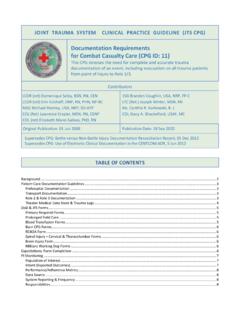Transcription of Chemical, Biological, Radiological and Nuclear (CBRN ...
1 JOINT TRAUMA SYSTEM CLINICAL PRACTICE GUIDELINE (JTS CPG). chemical , biological , Radiological and Nuclear ( cbrn ) Injury Part I: Initial Response to cbrn Agents (CPG ID: 69). This guideline is intended for use in conjunction with Tactical Combat Casualty Care (TCCC) guidelines as an organized approach to the care of chemical , biological , Radiological and Nuclear ( cbrn ) casualties in the deployed environment. Contributors LTC George Barbee HM1 Joshua Perez SFC David Hodge SFC Devin DeFeo MAJ Rodney Saunders LTC Darrell E. Jones MAJ Chris Gonzalez LTC Brock Benedict HMC John Martinez Lt Col Jill Harvilchuck COL Melissa Givens MAJ Doug Powell MSG Carl Hoover MAJ Louis Haase Col John Wightman COL (ret) James Madsen First Publication Date: 01 May 2018.
2 TABLE OF CONTENTS. 2. Basic Principles of cbrn Casualty Management .. 3. Critical Task List .. 3. Planning Considerations .. 4. Evacuation Planning Considerations .. 5. Medical 5. Landing Zone/Casualty Exchange Points .. 5. Evacuation Platforms .. 5. Protective Measures .. 5. Casualty 6. Decontamination .. 6. Identification of 7. Triage and Evacuation Priorities .. 8. Tactical Combat cbrn Casualty Care + cbrn .. 8. CRESS: A Simplified Approach to cbrn Casualty Assessment .. 9. (MARCHE)2: Integrating TCCC MARCH with cbrn First Response .. 11. Putting It All Together, Integrating CRESS and (MARCHE) .. 13. Evacuation Considerations.
3 16. References .. 17. Appendix A: (MARCHE)2 Summary .. 18. Appendix B: Casualty Decontamination 19. Appendix C: Casualty Care Cards .. 20. Appendix D: Additional Information Regarding Off-label Uses in CPGs .. 22. Guideline Only/Not a Substitute for Clinical Judgment 1. chemical , biological , Radiological and Nuclear ( cbrn ) Injury Part I: Initial Response CPG ID: 69. LEGEND OF TABLES AND FIGURES. Table 1. Examples of Military-issued PPE .. 4. Table 2. Field Expedient PPE Alternative .. 4. Figure 1. Casualty decontamination schematic.. 7. Figure 2. cbrn Casualties.. 9. Table 2. chemical casualty assessment .. 9. Figure 3. The acronym CRESS.
4 10. Table 3. CRESS finding for select chemical agents.. 11. Figure 4. (MARCHE)2 .. 12. Figure 5. Hot Zone/Care under fire immediate threats.. 12. Table 4. Point of Injury (Hot Zone) Response (M A R) .. 14. Table 5. Assessment at the Dirty CCP (Warm Zone) (M A R C H E) .. 15. Guideline Only/Not a Substitute for Clinical Judgment 2. chemical , biological , Radiological and Nuclear ( cbrn ) Injury Part I: Initial Response CPG ID: 69. INTRODUCTION. This Role 1 (including Point of Injury [POI]) through Role 3 Clinical Practice Guideline (CPG) is intended for use in conjunction with Tactical Combat Casualty Care (TCCC) Guidelines. This CPG is meant to provide medical professionals who encounter cbrn exposures with evidence-based guidance where it exists or consensus opinion when evidence is lacking.
5 This CPG is divided into 4 sections: 1. Response to cbrn agents (an approach to all cbrn casualties). 2. Medical management of chemical agent exposure 3. Medical management of radiation exposure and Nuclear events 4. Medical management of biologic agent exposure While encountering conventional casualties on the battlefield remains a more likely scenario, vigilance is necessary for unusual scenarios that might represent the first clue that a cbrn incident occurred. Since environmental sampling for agent detection and rapid point-of-care testing for agent identification will not be routinely available in austere environments or most hospital settings, the initial suspicion of a cbrn attack will rest on clinical recognition of signs and symptoms of poisoning.
6 This guideline is intended to provide an approach to casualty assessment and treatment from POI to established medical facilities. BASIC PRINCIPLES OF cbrn CASUALTY MANAGEMENT. Initial care of the cbrn casualty should be approached in the same manner as other casualties. Life threats require prompt recognition and intervention, and non-life-threatening sequelae can be addressed when clinically appropriate. Early recognition and categorization of cbrn -exposed patients is the foundation for further management, and is key not only for initiating patient treatment but also for preventing contamination of medical personnel, equipment, and facilities.
7 Thorough and appropriate decontamination is a core skill that requires planning and practice. Attention to details such as preventing hypothermia in patients undergoing decontamination and clinical reassessment at each stage of the process will reduce unnecessary morbidity. Basic life saving measures such as airway management and resuscitation are fundamental concepts that must be mastered at the appropriate level for each practitioner in the cbrn care chain. Furthermore, easy access to reference materiel to guide advanced therapy should be a part of every provider's armamentarium. These basic principles will be discussed in more detail in the sections that follow.
8 CRITICAL TASK LIST. The critical task list is applicable to both medical and non-medical personnel. All personnel should be trained on the concepts and principles identified in the critical task list in order to respond to cbrn casualties. The critical task list addresses core competencies that can be adjusted based on the medical skill level of the responder. These tasks should be trained according to service-specific publications and recognized standards of medical care. Recognize cbrn exposure that requires action to protect self and others Don personal protective equipment (PPE) to prevent exposure in self and assist others with PPE.
9 Egress from the threat Move upwind, uphill, upstream from threat Utilize time/distance/shielding for protection Guideline Only/Not a Substitute for Clinical Judgment 3. chemical , biological , Radiological and Nuclear ( cbrn ) Injury Part I: Initial Response CPG ID: 69. Recognize signs/symptoms of cbrn exposure that prompt immediate self-treatment or treatment of others ( nerve agent exposure). Apply TCCC integrated with cbrn response TCCC + cbrn = (MARCHE)2. Massive hemorrhage/mask, airway/antidote, respiration/rapid spot decontamination, circulation/. countermeasure, hypothermia/head injury, extraction/evacuation Apply airway management skills in a cbrn setting (positioning, suction, ventilation to include manual and mechanical, placement of definitive airway).
10 Perform Rapid Spot Decontamination Identify and establish Hot/Warm/Cold Zones Establish a dirty casualty collection point (CCP). Understand decontamination principles and casualty procedures for partial or complete removal of PPE, clothing, and equipment (casualty cut out). Understand cross contamination and take appropriate measures to prevent it Understand available technology that can aid in agent identification PLANNING CONSIDERATIONS. The response to cbrn exposure requires extensive planning based on the threat. In a high-threat environment, immediate availability of adequate PPE is essential. Personnel should also be aware of field expedient PPE.






